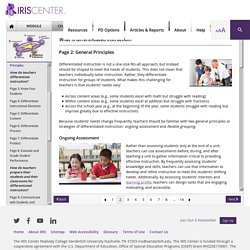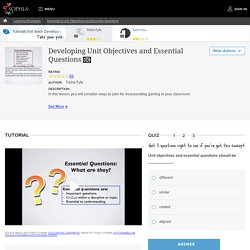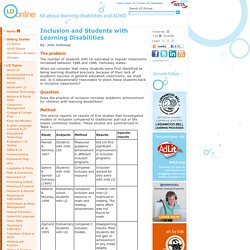

TESP 511 Session 7 Fall 2020 Bachrach/Dumas - Google Slides. TESP 511 Week 6 Fall 2020 Bachrach/Dumas - Google Slides. WebQuestExploratoryModel_intro.pptx. Jesus Teaching Through Discovery. Page 2: General Principles. Page 2: General Principles Differentiated instruction is not a one-size-fits-all approach, but instead should be shaped to meet the needs of students.

This does not mean that teachers individually tailor instruction. Rather, they differentiate instruction for groups of students. What makes this challenging for teachers is that students’ needs vary: Across content areas (e.g., some students excel with math but struggle with reading)Within content areas (e.g., some students excel at addition but struggle with fractions)Across the school year (e.g., at the beginning of the year, some students struggle with reading but improve greatly due to effective instruction) Because students’ needs change frequently, teachers should be familiar with two general principles or strategies of differentiated instruction: ongoing assessment and flexible grouping. Ongoing Assessment x learning profile Carol Ann Tomlinson Teachers can assess students in a number of ways. Exit Card Example. EL SDAIE Strategies. Costas levels. TESP511Week4Fall2020Dumas Bachrach (1) TESP 511 Session 2 Fall 2020 Dumas Bachrach (1)
TESP 511 Session 3 Fall 2020 Bachrach Dumas (3) (1) SMARTER Planning. Developing Unit Objectives and Essential Questions Tutorial. Download PDF Welcome, I'm Trisha Fyfe.

And in today's video lesson I'm going to be exploring the topic of developing unit objectives and essential questions. As we learn about this topic, we will work towards several learning objectives, and together we'll answer the following questions in this video lesson. What do essential questions look like in a unit study? What do learning objectives look like in a unit study? Let's start by looking at a sample lesson, and this lesson is in Understanding by Design format. So, here, our students will understand that perimeter and area are found using specific formulas. The essential questions for this unit are, how do perimeters and areas of similar shapes compare? Let's look at the lessons for this activity. The unit objectives for this lesson, or the key knowledge and skills, are as follows. These are the observable objectives.
Let's take a moment to go back to essential questions and talk about what exactly those questions are. Unit Rationale Guidelines1. ELD SDAIE Strategies. Integrated ELD in the ELA Classroom. Culturally Responsive Teaching Strategies and Examples. WebQuestExploratoryModel_intro.pptx. What Differentiated Instruction Is—and Isn't. Inclusion and Students with Learning Disabilities. By: John Holloway The problem The number of students with LD educated in regular classrooms increased between 1986 and 1996.

Holloway states: When we consider that many students were first identified as being learning disabled precisely because of their lack of academic success in general education classrooms, we must ask. Is it educationally reasonable to place these students back in inclusive classrooms? Question Does the practice of inclusion increase academic achievement for children with learning disabilities?
Method This article reports on results of five studies that investigated models of inclusion compared to traditional pull-out or the newer combined models. Conclusion Reading progress of students in the combined model was significantly better than either inclusion or the resource-room-only model. For more information on inclusion read: National Association of School Psychologist's position paper. 7. Differentiation Techniques for Special Needs Students - Differentiation & LR Information for SAS Teachers.
Students with special needs may need to have their work differentiated in a specific way to meet their IEP goals.

Below are some suggestions that can be integrated into lesson plans. Assessments - While students with special needs may become proficient readers and writers, they should not be limited to this to show what they know. Posters, models, performances, and drawings can show what they have learned in a way that reflects their personal strengths. When it comes to tests, there are other ways to show mastery than a multiple choice test. Rubrics are a great way to create assessment tools for students to show they have mastered the material. Case Study JC M.S.Specificlearningdisability. CSE17.3 Bergmann The Flipped Classroom. UDL: The UDL Guidelines.